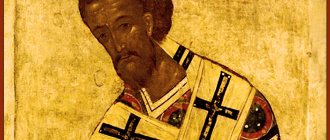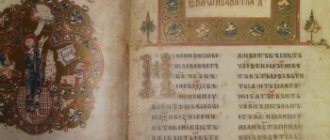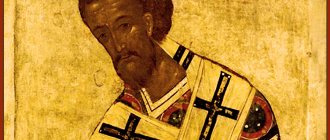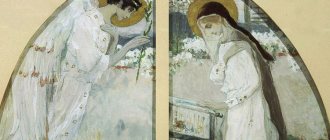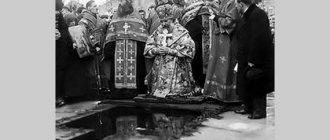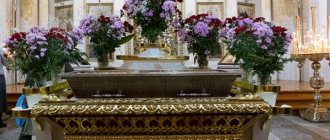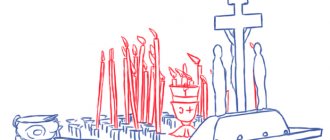| St. John of Shanghai |
John (Maximovich)
(1896-1966), Archbishop of San Francisco and Western America, Shanghai, saint, wonderworker Commemorated on the Saturday closest to June 19 (ROCOR), June 19 on the day of repose, September 29 on the day of the discovery of relics (ROCOR) , as well as in the Cathedral of Poltava Saints (Ukr.)
In the world Maksimovich Mikhail Borisovich, born on June 4, 1896 in the village of Adamovka, Kharkov province. At holy baptism he was named Michael in honor of the Archangel of the Heavenly Forces, Michael the Archangel. He came from the noble Maksimovich family, among his ancestors was the enlightener of Siberia, Saint John of Tobolsk. Mikhail's parents, Boris and Glafira, raised their son in piety, kindling in him the desire to stand for the truth and ardent love for the fatherland.
Mikhail was a sickly boy with poor appetite. Since childhood, he was distinguished by his deep religiosity, standing for long periods of time at night in prayer, diligently collecting icons, as well as church books. Most of all he loved to read the lives of saints. Michael fell in love with the saints with all his heart, became completely saturated with their spirit and began to live like them. And his aspirations were expressed in children's games - he turned toy soldiers into monks, and fortresses into monasteries. The Svyatogorsk monastery, located not far from the Maksimovich estate, disposed young Mikhail to a thoughtful attitude towards life. The child's holy and righteous life made a deep impression on his French Catholic governess, and as a result she converted to Orthodoxy.
Mikhail thought of devoting his life to serving his homeland, entering either the military or civil service. At first he entered the Petrovsky Poltava Cadet Corps, which he graduated in 1914. Then he studied at the Faculty of Law of the Kharkov Imperial University, from which he graduated in 1918. He studied excellently, although he devoted part of his time to studying the lives of saints and spiritual literature. Kharkov church life contributed to the initial steps of young Mikhail along the path of piety. In the tomb of the Kharkov Cathedral rested the relics of the wonderworker Archbishop Meletius (Leontovich), who spent his nights in prayer, standing with his hands raised. Michael fell in love with this saint and began to imitate him in the feat of night vigil. So, gradually, young Michael began to develop a desire to completely devote himself to God, and in connection with this, high spiritual qualities began to appear in him: abstinence and a strict attitude towards himself, great humility and compassion for the suffering. During his years of study, Archbishop Anthony (Khrapovitsky) had a particularly strong influence on him, who became his spiritual mentor, and Mikhail began to delve deeper into the study of spiritual life. In the end, as he recalled, the local monastery and temple became closer to him than any secular institutions.
The tragedy of 1917-1918 finally convinced him of human weakness, of the fragility of everything earthly. Preserving his whole life ardent patriotism, which became in him a belief in the revival of Holy Rus', he decided to renounce the world and devote himself entirely to serving God. During the civil war, the Maksimovic family was evacuated to Yugoslavia, where Mikhail entered the university at the Faculty of Theology in Belgrade, graduating in 1925. In order to feed his family, who found themselves in poverty, Mikhail had to sell newspapers. But his spiritual mentor, Bishop Anthony, also ended up abroad, and Mikhail continued to be cared for by him.
| Hieromonk John (Maksimovich). Photo 11.V.1934. |
Monasticism
In 1926, Mikhail was tonsured a monk with a name in honor of his ancestor St. John of Tobolsk. The tonsure was performed by Metropolitan Anthony at the Milkova monastery. Then, by the same bishop, he was ordained a hierodeacon, and on the feast of the Entry into the Temple of the Most Holy Theotokos he was ordained a hieromonk by Bishop Gabriel of Chelyabinsk. From the day of his monastic tonsure, Father John never again slept lying on his bed - if he fell asleep, then on a chair or on his knees under the icons. He was constantly in prayer, ate food once a day and served the Divine Liturgy daily.
Hieromonk John especially devotes the first years of his monastic life to youth - since 1929 he has been teaching and being an educator at the theological seminary in the city of Bitola. Already at that time, Saint Nicholas (Velimirovich), the Serbian Chrysostom, gave the following characterization to the young hieromonk: “ If you want to see a living saint, go to Bitol to Father John
". Father John quickly won the love of the students with his ability to inspire them with high Christian ideals and he himself treated them like a loving father - at night he walked around the hostel and made the sign of the cross over those sleeping.
During this period, at the request of the local Greeks and Macedonians, he began to serve for them in Greek. At the same time, Hieromonk John began visiting hospitals and looking for sick people in need of prayer, consolation and communion.
Bishop of Shanghai
Since the fame of Hieromonk John continuously grew, the bishops abroad decided to elevate him to bishop. Wanting to evade such a high title, he began to refer to his tongue-tiedness, but the bishops remained adamant, pointing out to him that the prophet Moses was tongue-tied.
In May 1934, Hieromonk John was consecrated Bishop of Shanghai, Vicar of Beijing, and left to join his flock. This was the last consecration performed by Metropolitan Anthony (Khrapovitsky). In a letter to Bishop Demetrius of Hailar, Bishop Anthony wrote this about Father John: “Like my soul, like my heart, I send Vladyka Bishop John to you. This small, weak man, almost a child in appearance, is some kind of miracle of ascetic fortitude in our time of general spiritual relaxation.”
The new bishop arrived at his see on the day of the Feast of the Entry of the Most Holy Theotokos into the Temple and continued his pastoral and ascetic work here with redoubled zeal. Here he immediately set about restoring church unity, establishing contact with local Orthodox Serbs, Greeks and Ukrainians. Possessing inexhaustible energy, Bishop John was the inspirer of many undertakings in Shanghai and took an active part in many public affairs of the Russian community. Here he completed the construction of a new cathedral in honor of the icon of the Most Holy Theotokos “Helper of Sinners”, erected the majestic St. Nicholas Church - “Temple-Monument to the Tsar Martyr Emperor Nicholas II and His August Family”, founded a home for the elderly and an orphanage in honor of St. Tikhon Zadonsky. The bishop populated the orphanage with abandoned children, whom he himself fearlessly collected from the streets and slums of Shanghai. At first, the orphanage housed eight orphans; over the years, it began to provide shelter to hundreds, and in total, 1,500 children passed through it. The children, despite the bishop’s usual severity, were absolutely devoted to him, and the saint himself labored for them before the Lord. So, when during the war the orphanage did not have enough food to feed the children, the bishop prayed all night, and in the morning he received a call: a representative of some organization had arrived with a large donation for the orphanage.
| St. John (Maksimovich). Photo |
As before, the saint strengthened himself and enlightened his flock with the daily celebration of the Divine Liturgy.
The Bishop was very strict at the altar, demanded precise knowledge of the rules and adherence to them, prohibited any conversations during the service, and very often remained in the temple for a long time after the service. Then he visited the sick daily, accepting confession and communicating the Holy Mysteries to them. If the patient’s condition became critical, the bishop came to him at any hour of the day or night and prayed for a long time at his bedside. There are numerous cases of healing of hopelessly sick people through the prayers of St. John, his unexpected appearances at the most needed moment. The saint visited prisoners in prisons, and the mentally ill and possessed in a hospital for the insane. And everywhere he evangelized and preached, awakening the conscience of some and warming the hearts of others. The strictest ascetic life of the ruler was expressed not only in fasting (he ate food only once a day, and during fasting he ate only prosphora) and depriving himself of sleep. To avoid worldly fame and attention, the ruler adopted the traits of foolishness, in which his feat shone even brighter. Thus, Saint John walked everywhere either barefoot or wearing only sandals, even in winter. He wore his cassock to such disrepair that it looked more like a beggar’s clothes. According to some, the bishop’s tongue-tiedness was explained by the fact that he was so exhausted that his lower jaw sagged from weakness and did not allow him to speak clearly. However, as a former servant of the ruler of those years said, who began to imitate him in Lenten feats and alarmed his parents, the saint, having learned about this, ordered him to eat sausages during Great Lent and always remember that obedience to parents is more important than unauthorized feats.
Between the Moscow Patriarchate and the Church Abroad
During the wartime Japanese occupation, Vladyka declared himself the temporary head of the Russian colony and showed great courage in defending the Russians before the Japanese authorities. During this period, communication with the Synod of Bishops of the Church Abroad was interrupted, and the Far Eastern Metropolitan District found itself in conditions of forced self-government. After the bishops of the Harbin diocese and Bishop Nestor (Anisimov) recognized Patriarch Alexy of Moscow and All Rus' as their kiriarch in 1945, Bishop John was also inclined to follow them, “since, in his words, he was legally recognized as his Local , and all other Local Churches of the Patriarch have no doubts.” However, when Vladyka John learned about the continuation of the activities of Metropolitan Anastassy, he considered himself obliged to remain, as before, in obedience to the First Hierarch of the Church Abroad. Finding himself the only Far Eastern bishop under the jurisdiction of the Russian Orthodox Church Outside of Russia, by decision of the Munich Council of Bishops of May 10, 1946, he was appointed an independent bishop and elevated to the dignity of archbishop. The followers of the Church Abroad in China rallied around him [1].
Exodus from China
| St. John (Maksimovich). Icon from Ireland. |
With the communists coming to power in China, Russians who had not accepted Soviet citizenship were again doomed to exodus.
Most of the Bishop's Shanghai flock went to the Philippines - in 1949, approximately 5 thousand Russians from China lived on the Philippine island of Tubabao in a camp of the International Refugee Organization. The island was in the path of seasonal typhoons that sweep across this sector of the Pacific Ocean. However, during the entire 27 months of the camp's existence, it was only once threatened by a typhoon, but even then it changed course and bypassed the island. When a Russian mentioned his fear of typhoons to the Filipinos, they said that there was no reason to worry, since “your holy man blesses your camp every night from all four sides.” When the camp was evacuated, a terrible typhoon hit the island and completely destroyed all the buildings. The Russians not only survived on the island, but were also able to leave it thanks to the saint, who himself traveled to Washington and ensured that American laws were amended and most of the camp, about 3 thousand people, moved to the United States, and the rest to Australia.
Archbishop of Western Europe
In 1951, Archbishop John was appointed to care for the flock of the Russian Orthodox Church Abroad in Western Europe and Africa with the title “Brussels and Western Europe” and with a see in Paris. Vladyka remained the ascetic, strict bishop, sacrificial shepherd and spiritual man of prayer that he was at the Shanghai see, and in Western Europe, yearning for true holiness, the craving of many non-Orthodox people for the vessel of God's grace was clearly manifested.
| Saint John of Shanghai and San Francisco. Icon from the church in the name of all the saints who have shone in the Russian land, Paris. |
Here the Bishop began to restore the memory and veneration of the ancient Orthodox saints of the West and brought many converts from local peoples into the fold of the Church, joining many French and Dutch parishes to the Church Abroad. His fame spread throughout the entire population. So, in one of the Catholic churches in Paris, a local priest tried to inspire young people with the following words: “You demand proof, you say that now there are no miracles or saints. Why should I give you theoretical proofs when today Saint Jean Barefoot walks the streets of Paris? In Paris, the railway station dispatcher delayed the departure of the train until the arrival of the “Russian Archbishop”. All European hospitals knew about this bishop, who could pray for the dying all night. He was called to the bedside of the seriously ill - whether he was Catholic, Protestant, Orthodox or anyone else - because when he prayed, God was merciful. So, in a Paris hospital there was an Orthodox woman who was embarrassed in front of her neighbors in the ward when a ragged and barefoot bishop arrived at her. But when he gave her the Holy Gifts, the Frenchwoman on the nearest bed said to her: “How lucky you are to have such a confessor. My sister lives in Versailles, and when her children get sick, she drives them out into the street where Bishop John usually walks and asks him to bless them. After receiving the blessing, the children immediately recover. We call him a saint."
Archpastor of San Francisco
In 1962, due to difficulties with the construction of a new cathedral in San Francisco, Saint John, at the request of thousands of the bishop's former Shanghai flock who now lived there, was appointed to the Western American See. At this time, the bishop’s longtime friend, Archbishop Tikhon of San Francisco, retired; in his absence, the construction of the cathedral was suspended, and the quarrel paralyzed the community. The saint endured many sorrows here; he was even forced to appear in a civil court and give an answer to absurd accusations of shortcomings of the parish council. But with love and patience the saint brought the matter to an end, and in 1964 the cathedral in honor of the icon of the Mother of God “Joy of All Who Sorrow” was erected. And in the last years of his earthly life, despite the enmity, the saint continued to work miracles with his constant prayers.
Demise and veneration
| Relics of St. John of Shanghai in the San Francisco Cathedral of Joy and Sorrow |
According to several testimonies, Bishop John foresaw the time and place of his death.
He died on July 2, 1966, on the day of remembrance of the Apostle Jude, during an archpastoral visit to the city of Seattle with the miraculous icon of the Mother of God of Kursk-Root, at the age of 71 years. He served the Divine Liturgy and remained in the altar alone with the icon for another three hours; then, having visited the spiritual children near the cathedral with a miraculous image, he proceeded to the room of the church house where he was staying. The servants seated the Lord in a chair and saw that he was already leaving.
Sorrow filled the hearts of many people around the world who loved the great archpastor. A Dutch Orthodox priest wrote with a contrite heart: “I no longer have and will no longer have a spiritual father who would call me at midnight from another continent and say: “Go to sleep now. What you pray for, you will receive."
The bishop lay in the coffin for six days, but, despite the heat, no smell of decay was felt, and his hand remained soft. The funeral service was led by Metropolitan Philaret (Voznesensky). At the funeral service, both the multitude of those gathered and the bishops themselves who performed the service could not restrain their sobs. It is surprising that at the same time the temple was filled with quiet joy. Eyewitnesses noted: it seemed as if they were present not at a funeral, but at the opening of the relics of a newly discovered saint.
The saint was buried in a tomb under the cathedral he built. Soon miracles of healing and help in everyday affairs began to happen here. Time has shown with many evidence that Saint John the Wonderworker is a quick helper to all those in troubles, illnesses and sorrowful circumstances.
In 1994, a special commission for the glorification of the bishop discovered his relics incorrupt, and on July 2, 1994, the Russian Orthodox Church Outside of Russia canonized St. John (Maximovich) of Shanghai and San Francisco, the wonderworker. His church-wide glorification in the Russian Orthodox Church was accomplished by the decision of the Council of Bishops on June 24, 2008.
Childhood
In the world, Mikhail Borisovich Maksimovich belonged to a famous noble family. His paternal grandfather was a wealthy landowner. Another grandfather, on his mother’s side, served as a doctor in the city of Kharkov. His father led the local nobility, and his uncle served as rector of Kyiv University.
The future saint was born on June 4, 1896, on the territory of the Kharkov province, on his parental estate Adamovka. In holy baptism he received the name Michael, in honor of the Archangel of the Heavenly Host.
Mikhail's parents, Boris and Glafira, Orthodox people, strove to give their son a good upbringing and education, and in many ways they themselves served as a good example for him. Subsequently, throughout his life he felt filial respect for them.
Since childhood, Mikhail had poor health. The child’s peaceful and meek character contributed to building friendly relationships with others, including peers, but he did not have particularly close friends. Perhaps it was precisely in this regard that Mikhail rarely participated in games, but more often than not he plunged into his own thoughts.
Distinguished by his special religiosity since childhood, he loved to play “monasteries”, building them from toy forts, dressing toy soldiers in “monastic” clothes. As he grew older, he began to collect a religious library, holy icons, and became involved in prayer.
He literally devoured spiritual literature, the Lives of saints, and historical works. Along with religious feelings, from an early age a feeling of love for his Motherland and a sense of patriotism matured in him.
Mikhail was greatly impressed by his visit to the Svyatogorsk Monastery, not far from which, in Gola Dolina, his family’s country estate was located. The family has supported this monastery more than once with its donations.
By striving to please God and living according to the commandments, Mikhail had a beneficial influence on his younger brothers and sister (and not only: over time, even his governess, a Frenchwoman, being a Catholic, decided to convert to Orthodoxy).
Youth years
At the age of 11, Mikhail’s parents assigned him to the cadet corps in Poltava.
He studied well, excelling in almost all subjects. And only physical training was difficult for him.
Mikhail's meek, religiously inclined disposition set him apart from his comrades in the corps. Once, when the students were marching solemnly and their ranks reached the Poltava Cathedral, Mikhail, driven by an inner feeling of reverence, made the sign of the cross. The leadership wanted to punish him for violating order and discipline, and only the intercession of the corps trustee, Grand Duke Constantine, who showed the proper pedagogical tact and approach, saved the “culprit” from condemnation.
Student years
When Mikhail graduated from the cadet corps in 1914, he was faced with a choice: where to go to study next? He himself was thinking about the Kyiv Theological Academy, but his parents, who wanted their son to have a good legal career (which was realistic, given his talents and their personal connections), insisted that he enter the Faculty of Law. Having sincere respect for his father and mother, he submitted to their will and entered Kharkov University.
While studying at the university, Mikhail demonstrated enviable success. However, even his busy schedule did not distract him from his highest spiritual aspirations. He continued to study religious literature, the Lives of God's saints. Moreover, life experience and the knowledge acquired during the learning process helped him to perceive more deeply and seriously those religious truths that he had previously looked at with childish and youthful spontaneity.
History of the relics of the saint
In 1993, the clergy removed the lid from the saint’s coffin: the relics turned out to be incorrupt.
All muscles and tendons, even hair and nails were well preserved.
After anointing his body with oil, the saint was dressed in white bishop's robes.
For the last time, the clergy sang the funeral litany, performed for ordinary deceased. Then the troparion was solemnly performed to Father John, who was now addressed in prayer as a holy ascetic.
The holy relics are located in the San Francisco Cathedral, dedicated to the icon of Our Lady “Joy of All Who Sorrow.” An unquenchable lamp glows near the shrine; candles are always burning.
The relics of the saint have the blessed power to heal from illnesses; many who pray at the shrine testify to quick help in various life circumstances.
Post-revolutionary period
The time of completion of training coincided with the time of terrible, tragic events in the life of the Fatherland: the February Revolution and the changes that followed it. Neither he himself nor his parents shared the revolutionary joy of the overthrow of the Russian Tsar. One could even say that for Mikhail’s family those cold February days became days of sadness and mourning.
A few months after the February Revolution, the October Revolution followed. Following this, persecution of the clergy and zealous Christians in general began. Temples collapsed, Christian blood flowed.
Michael, sincerely absorbed in the thought of serving God, found it difficult to accept the new political reality. Knowing the tenacity with which he was ready to defend the truth, his family and friends were worried about him.
Canons and akathists
A canon is a special genre of prayer that has ancient origins. The canons are used in every evening service and consist of 8 or 9 songs. Such prayers can be dedicated to God, the Mother of God or saints.
The canon of Saint John tells about events from his life; in prayer there are petitions for the saint's intercession before God.
Akathist is a type of prayer of praise that glorifies the earthly life and deeds of a saint or the Mother of God. This prayer is practically not used in Divine services; it is often sung at prayer services or read at home. The akathist consists of 12 ikos and 12 kontakia, read alternately.
The akathist praises the Christian exploits and virtues of St. John; he is called a quick helper in troubles.
Emigration
By the providence of God, Mikhail left his native, beloved Fatherland, and ended up in Belgrade. Here he entered the local university, the Faculty of Theology, and graduated in 1925.
In 1924 he was elevated to the rank of reader.
In 1926, he was tonsured as an angel by Metropolitan Anthony (Khrapovitsky). Michael's new monastic name became: John. So it was named in honor of the servant of God, a representative of his family, St. John of Tobolsk.
Monastic life
After taking monastic vows, John surrendered so much to the desire to follow Christ that, for example, one of the bishops who knew him personally, Nikolai (Velimirović), popularly called the Serbian Chrysostom, said that if anyone wants to see today’s saint, let him turn to Father John.
For some time, Father John worked in the gymnasium of the city of Velikaya Kikinda, as a teacher of the law, then as a teacher at the theological seminary in the city of Bitola. When presenting the educational material, he tried to do it in an accessible and clear manner. The students treated him with love.
In 1929, by decision of the church authorities, Father John was elevated to the rank of hieromonk.
He treated the fulfillment of his duty as a priest with all seriousness and responsibility. He constantly took care of his flock. He taught them by word and example, regularly served the Divine Liturgy and received the Body and Blood of Christ, strictly fasted, and indulged in prayer vigils (sometimes he did not even go to bed, remaining on the floor, right in front of the images of the saints).
During this period, Father John wrote several significant (later widely known) theological works.
Miracles of the Saint
Even during his lifetime, extraordinary events took place through the prayers of the saint. There is a large number of oral and written testimonies about the miracles of the saint.
Orthodox Brotherhood of St. Germana in America annually receives dozens of letters from people who received help after praying to the bishop.
During the archpastor's stay on Tubabao, strange cries attracted his attention. The nurse explained that this was a terminally ill woman screaming, who was even isolated from other patients so as not to disturb them. The Bishop went to the sufferer, who also emanated a terrible smell. He confessed and gave communion to the sick woman, and the next time he visited the hospital, she herself came out to meet him.
In 1948, a patient was dying in the hospital, who really wanted to take communion from the hands of Father John. He asked the nurses to call the bishop, but this was impossible due to the line being damaged by the typhoon. After some time, there was a knock on the gate, the saint arrived, explaining his visit by saying that someone was waiting for him here.
One day, the orphanage ran out of food supplies; since it was during wartime, it was not so easy to get food. Saint John spent the whole night in fervent prayer to God. The next morning, a large donation from some organization was sent to the shelter.
Episcopal ministry
In 1934, Father John was honored with consecration as a bishop and humbly departed for the place of his new ministry—Shanghai.
In addition to participating in divine services and preaching, organizing parish life, missionary work, and charity, the saint was also involved in personally visiting many sick people, inspiring them with kind pastoral words, confessing and administering the Holy Gifts. They say that, if necessary, the bishop went to the patient at any time of the day or night.
In 1949, due to the strengthening of communist sentiments in China, Bishop John was forced to leave for the Philippine island of Tubabao, where he stayed in a specially equipped camp along with other refugees.
Showing concern for his flock, the bishop traveled to Washington and asked for refugees to be accepted. His requests and, of course, prayers did not remain in vain. A significant part of the refugees were able to resettle in America, and others in Australia.
In 1951, the bishop was appointed archbishop of the Western European Exarchate, subordinate to the Russian Church Abroad.
In 1962, with the blessing of the leadership, he moved to the United States, where he headed the Diocese of San Francisco.
The local Christian community there was not in the best condition. In addition to general difficulties (including financial ones), internal schismatic sentiments and movements did not contribute to the normal functioning of the department.
With the arrival of the saint, life in the diocese began to improve. However, not everyone accepted the bishop’s good initiative with enthusiasm. There were envious people and ill-wishers. Intrigues began to be built against the bishop, and denunciations began to pour in to the church leadership. Meanwhile, with the help of God, this situation was resolved in favor of St. John.
On July 2, 1966, while visiting the city of Seattle on a pastoral mission, during a cell prayer, the Bishop’s heart stopped and he quietly went to the Heavenly King. It is alleged that the ruler knew in advance about the approach of death.
Saint John is revered by the Church not only as an outstanding saint, but also as a miracle worker.
Demise
In the summer of 1966, the archpastor arrived in Seattle with the Kursk-Root Icon of the Mother of God. After the liturgy, the bishop visited the spiritual children living nearby, and then went to the house at the temple, where he stayed. The saint died on the same day—July 2—at the age of 71.
During the funeral service, the temple was filled with a large number of people and clergy, many were crying, as if experiencing the death of their own father.
But, despite the grief, according to eyewitnesses, everyone felt a surge of grace and spiritual uplift.
For six whole days the archpastor lay in the coffin, and no one felt absolutely any odors, although it was a hot summer. Those who came to say goodbye to the dear shepherd noted that his hands remained soft all these days.
Prayer to Saint John, Archbishop of Shanghai, Wonderworker
O our holy father John, good shepherd and seer of the mysteries of human souls! Now at the Throne of God you pray for us, just as you yourself said after death: “Even though I am dead, I am alive.” Beg the all-generous God to grant us forgiveness for our sins, so that we may rise up cheerfully and cry out to God to grant us the spirit of humility, the fear of God and piety in all the paths of our lives, like mercy You have been a great syrup-giver and skillful mentor on earth, now be a guide for us even in church turmoil Christ's admonition. Hear the groaning of the troubled youths of our hard times, overwhelmed by the demon of the all-evil one, and look at the despondency of the exhausted shepherds from the oppression of the corrupting spirit of this world and those languishing in the negligence of the right Come and hasten to prayer, we cry out to you tearfully, O warm man of prayer; visit us orphans, scattered all over the world and living in our fatherland, wandering in the darkness of passions, but with weak love for the light of Christ, drawn and waiting for your fatherly instruction, may it be good Let us get used to this and we will appear as heirs of the Kingdom of Heaven, where you are with all the saints, glorifying the Lord our Jesus Christ, to Him is honor and power, now and ever and unto ages of ages. Amen.
Prayer (other)
O wonderful Saint John, you have only spread your heart, as if it comfortably accommodates many people who worship you from different tribes and peoples! Look at the wretchedness of our words, both brought to you out of love, and help us, saint of God, from now on to cleanse ourselves from all filthiness of the flesh and spirit, working for the Lord with fear and rejoicing in Him with trembling. And that we will reward you for this joy, even if we felt it, seeing your holy relics in the holy temple and glorifying your memory; Truly, there is no imam to repay, but if we begin to correct ourselves, what is new instead of what is old. Sowing the grace of renewal, be our intercessor, Saint John, help us in our weaknesses, heal illnesses, heal passions with your prayers; reposed from this time into another eternal life, instruct you in the same way, the Most Pure Lady, Hodegetria of the Russian Dispersion, with Her miraculous icon of the Root-Kursk, which is You appeared on the day of your repose, rejoicing now in the face of the saints glorifying the One God in the Trinity , Father and Son and Holy Spirit, now and ever and unto ages of ages. Amen.
Canonization and veneration
Saint John was canonized by the Russian Orthodox Church Abroad in 1994. The date of the church-wide glorification of the archpastor by the Council of Bishops of the Russian Orthodox Church is June 24, 2008.
The glorification of the bishop in the Church Abroad attracted a large number of people from all over the world. The canonization was not entirely ordinary, because only 28 years had passed since the death of the elder - a rather short period of time. However, the veneration of the saint was so great that few doubted his holiness.
